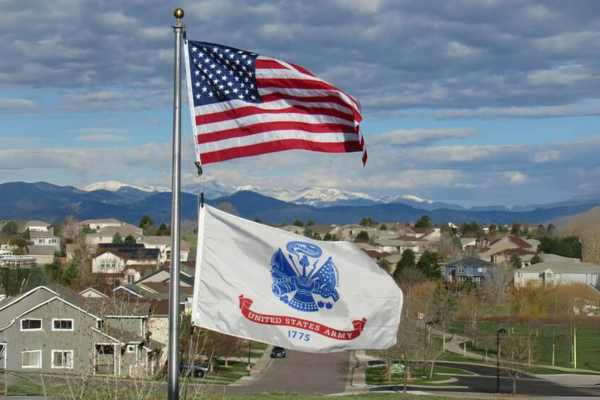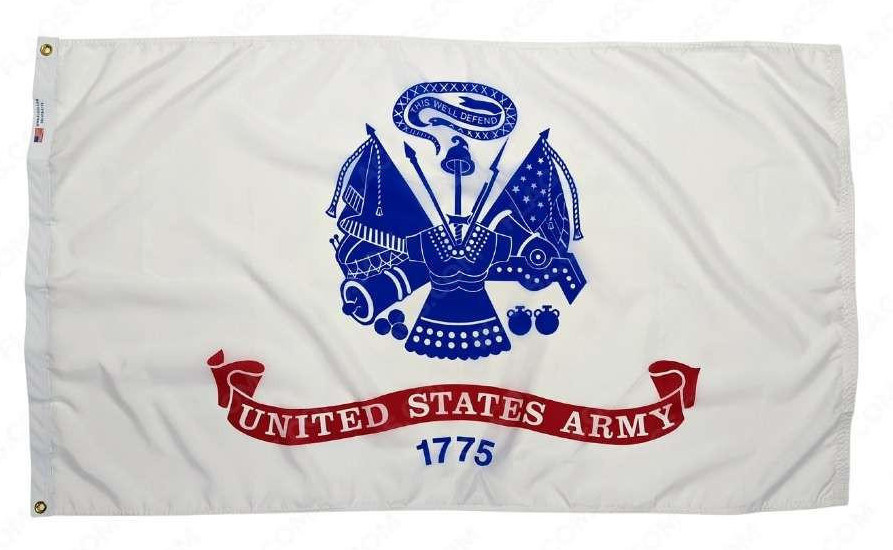Army Flag FAQ
As a symbol of one of America’s oldest military branches, the Army flag is proudly flown by servicemembers and citizens alike. The main design element dates back to the American Revolution and is full of symbolic icons with underlying meanings. As the flag and flagpole experts, we’ve compiled a great deal of information about the US Army flag and the rules governing its display.
- What is the History of the Army Flag?
- What Does the Army Flag Look Like?
- What is the Meaning Behind the Army Flag?
- How Do I Hang the Army Flag Vertically?
- How Do I Display the American and Army Flags Together?
- What is the Order of Armed Forces Flags?
- What Does the Blue Army Flag Mean?
What is the History of the Army Flag?
Despite the US Army’s founding in 1775, this Armed Forces branch would not receive a dedicated flag until the mid-20th century. In 1955, Secretary of the Army Brucker initiated the creation of a flag to represent the Army in joint service ceremonies with other branches.
A design for the flag was approved on April 12, 1962, and formally unfurled for the first time on June 14 of that year, the anniversary of the US Army’s founding. The design of the flag has remained unchanged since.
What Does the Army Flag Look Like?
The US Army flag is striking, with its clean white field setting off a vibrant blue War Office Seal at the center. Beneath this historic emblem, a bold red streamer carries the proud declaration “United States Army” in crisp white letters, underscored by the founding year, 1775. This visual tribute to the Army's heritage is both commanding and dignified.
What is the Meaning Behind the Army Flag?
The heart of the Army flag is the War Office Seal, a symbol that has evolved subtly since the American Revolution. Central to the design is a Roman cuirass, an emblem of strength and resilience. Encircling the cuirass are an array of military icons—the traditional tools of the Army—including cannonballs, cannons, spontoons, swords, muskets with bayonets, mortars, and bombshells.
Perched atop the sword is a Phrygian cap, a classic emblem of freedom. Above it, a rattlesnake poised to strike unfurls a banner proclaiming “This We’ll Defend”—a nod to the colonies' united front against British domination during the Revolution.
On the left, a drum with drumsticks symbolizes the Army's role in rallying and serving the nation, while above it waves a blank flag with fringe. To the right, an early American flag waves, completing a scene that is rich with history and symbolism. The Army flag is not just a banner but a storytelling canvas, documenting centuries of bravery and service.
How Do I Hang the Army Flag Vertically?
The US Armed Forces Institute of Heraldry does not specify that the Army flag should face a particular direction when hung vertically. It is acceptable for the flag to face either left or right. If you are unsure, it is best to hang the flag horizontally.
How Do I Display the American and Army Flags Together?
The American flag takes precedence over the Army flag. If they are being flown from the same flagpole, the Army flag should be lower on the pole and be of the same or smaller size. The American flag should be on the observer’s far left for displays on separate poles. An exception to this rule is when the flagpoles are of different heights; in this case, the American flag should be on the highest pole in the center.

What is the Order of Armed Forces Flags?
When displayed together, the order of the Armed Forces flags should be as follows: Army flag, Marine Corps flag, Navy flag, Air Force flag, Space Force flag, and Coast Guard flag. During times of war, the Coast Guard flag should be placed in between those of the Navy and Air Force.

What Does the Blue Army Flag Mean?
The United States Army flag that uses a blue background instead of white is known as the Army ‘field flag’ and is used only by American troops during war. This flag inverts all of the colors of the primary Army flag so that it depicts a white War Office Seal on a dark blue field.

If you have any other questions about US Army flags or other service banners, don’t hesitate to contact us at customerservice@flags.com or 800-858-8776.
Recent Posts
-
The Best American Flag: A Durability Study
At Flags.com, we're not just passionate about providing the best American flags; we're also commi
-
Army Flag FAQ
As a symbol of one of America’s oldest military branches, the Army flag is proudly flown by servi

